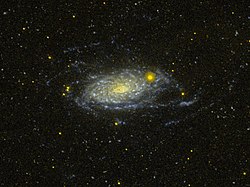Messier 63
Appearance
| Sunflower Galaxy | |
|---|---|
 M63 from GALEX sky survey | |
| Observation data (J2000 epoch) | |
| Constellation | Canes Venatici |
| Right ascension | 13h 15m 49.3s[1] |
| Declination | +42° 01′ 45″[1] |
| Redshift | 504 km/s[1] |
| Distance | 37 Mly[2] |
| Apparent magnitude (V) | 9.3[1] |
| Characteristics | |
| Type | SA(rs)bc[1] |
| Apparent size (V) | 12′.6 × 7′.2[1] |
| Other designations | |
| M63, NGC 5055, UGC 8334, PGC 46153[1] | |
The Sunflower Galaxy (also known as Messier 63, M63, or NGC 5055) is a spiral galaxy in the constellation Canes Venatici consisting of a central disc surrounded by many short spiral arm segments. The Sunflower Galaxy is part of the M51 Group, a group of galaxies that also includes the Whirlpool Galaxy (M51).
History
The Sunflower Galaxy was discovered by Pierre Méchain on June 14, 1779.[3] The galaxy was then listed by Charles Messier as object 63 in the Messier Catalogue.
In the mid-19th century, Lord Rosse identified spiral structure within the galaxy, making this one of the first galaxies in which such structure was identified.[3]
In 1971, a supernova with a magnitude of 11.8 appeared in one of the arms of M63.
Gallery
-
Messier 63, 24 inch telescope on Mt. Lemmon, AZ.
-
Messier 63 seen in infrared by the Spitzer Space Telescope.
References
- ^ a b c d e f g "NASA/IPAC Extragalactic Database". Results for NGC 5055. Retrieved 2006-10-10.
- ^ Frommert, Hartmut & Kronberg, Christine (2002). "Messier Object 63". Retrieved Dec. 6, 2006
- ^ a b K. G. Jones (1991). Messier's Nebulae and Star Clusters (2nd edition ed.). Cambridge: Cambridge University Press. ISBN 0-521-37079-5.
{{cite book}}:|edition=has extra text (help)
External links
Wikimedia Commons has media related to Sunflower Galaxy.
- The Sunflower Galaxy on WikiSky: DSS2, SDSS, GALEX, IRAS, Hydrogen α, X-Ray, Astrophoto, Sky Map, Articles and images
- Sunflower Galaxy @ SEDS Messier pages



